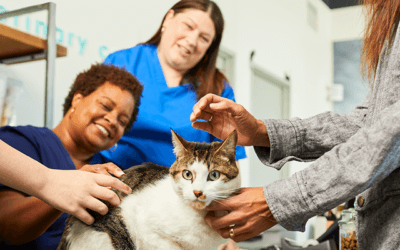Three things well-managed practices typically have in common are organized teams, distinct team leaders with defined responsibilities, and Standard Operating Procedures (SOPs). There are endless benefits to creating Standard Operating Procedures for your veterinary practice! Unique to each clinic, SOPs are vital to patient care and safety. Not only do SOPs streamline training, but they act as established, reliable tools readily available to address system errors. It’s important that they can be edited and updated quickly, as needed.
[bctt tweet=”Not only do Standard Operating Procedures streamline training, but they act as established, reliable tools readily available to address system errors in the practice.”]
Why Standard Operating Procedures?
 Three key benefits of implementing Standard Operating Procedures in your veterinary practice are consistency, improved efficiency and training. With SOPs in place, you can expect consistent results, streamlined processes and ensure you’re training without gaps. Adhering to SOPs also provides the opportunity to easily conduct employee reviews based on practice standards and make sure team members are working within established parameters.
Three key benefits of implementing Standard Operating Procedures in your veterinary practice are consistency, improved efficiency and training. With SOPs in place, you can expect consistent results, streamlined processes and ensure you’re training without gaps. Adhering to SOPs also provides the opportunity to easily conduct employee reviews based on practice standards and make sure team members are working within established parameters.
Guidelines for creating Standard Operating Procedures
- SOPs should be documented and worded in a way that is easy for someone new to the task to understand.
- Try not to abbreviate or use too much technical jargon.
- SOPs should state a clear goal and focus on one specific task.
- SOPs should describe work flow, list equipment needed, and outline the roles and responsibilities of the employees involved. Creating lists for individual team members detailing their specific tasks is useful.
- Make sure documentation is readily available for training new team members and for on-site reference. SOPs should be easily accessed as a reference if/when needed.
SOPs should be regularly evaluated for content, accuracy, clarity, simplicity and necessity. They should be revised as needed in real time.
Who should create Standard Operating Procedures
 Before you start, your practice should set limitations on who has input into developing SOPs. It’s advisable to have at least one doctor as well as a manager or area supervisor create, teach and edit SOPs. Remember that this is not a group activity, as too many influencers can lead to confusion and frustration. And be sure to decide beforehand what constitutes a consensus when forming SOPs. Remember—the goal is to standardize ONE consistent way of performing tasks; there should never be more than one SOP per task!
Before you start, your practice should set limitations on who has input into developing SOPs. It’s advisable to have at least one doctor as well as a manager or area supervisor create, teach and edit SOPs. Remember that this is not a group activity, as too many influencers can lead to confusion and frustration. And be sure to decide beforehand what constitutes a consensus when forming SOPs. Remember—the goal is to standardize ONE consistent way of performing tasks; there should never be more than one SOP per task!
How to establish priorities
If you don’t know where to start, consider a task that employees are struggling with. Are your techs having a hard time with consistent, thorough surgical sterilization? Are your receptionists forgetting to send home meds? Pick one specific issue, document the process step-by-step, then have relevant team members review the SOP and refer back/edit as needed. Once you get the hang of creating SOPs and see how efficient they are at streamlining processes, you’ll want to create them for every task!
Example Standard Operating Procedure
 |
My practice’s simple SOP for “Filling Prescriptions Correctly” is laminated and posted by our prescription label printer: |
Standard Operating Procedure for: Filling Prescriptions Correctly
- Be mindful, focus
- Double check with tech or doctor if unsure of drug or instructions
- Initial prescription label
- Fill scripts for appointments immediately, take meds in room and go over instructions with owners
- Don’t avoid filling prescriptions—if you touch the label, you fill it
Six “Rights” of Filling Prescriptions:
- Right Patient?
- Right Medication?
- Right Dose?
- Right Directions?
- Right Dosing Schedule?
- Write Your Initials on the Label!
Key benefits SOPs bring to your practice
[bctt tweet=”Following Standard Operating Procedures helps guarantee consistency, improves outcomes and provides a framework for continuous improvement.”] It will simplify your team’s ability to organize, train, function and lead. It will lead to mindfulness of the of processes and reinforce key points in work flow; it will also quickly address points of failure.
| Training: SOPs will clarify and reinforce goals | |
| Efficiency: SOPs will boost productivity and streamline processes | |
| Reduce adverse events: SOPs are designed for quality assurance and continuous improvement |
If you aren’t currently working with SOPs in your practice, my recommendation is to start simple with one or two less complex processes; get feedback, learn and tweak as needed! Good luck!
Meghan S. Bingham, CVPM, is the practice manager at a 10-doctor, small-animal practice in Houston, Texas. She can be reached at [email protected].



